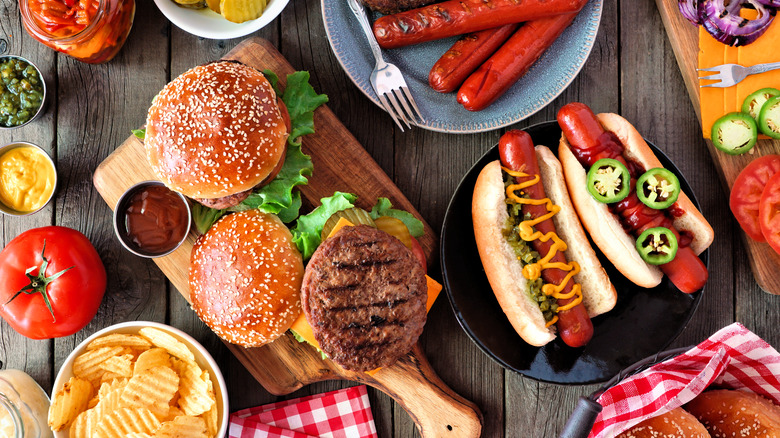The Reason Comfort Foods Are An Important Part Of Labor Day Feasts
This Labor Day, chances are you'll be enjoying some of your favorite comfort foods with neighbors, friends, and family. It's for good reason that barbecues, picnics, and block party buffets are ingrained traditions of the Labor Day festivities. Much of this association with comfort food revolves around the history of the holiday and where it happens to land on the calendar. Its origins go back to the labor movements of the late 19th century when unions were working to end the onerous 72-hour work week, demanding an eight-hour work day, and staging marches as far back as 1882.
Though the eight-hour workday was still a ways off (that would be enacted in 1912), government officials began to warm to the idea of creating a federal holiday recognizing the efforts of the working class. The holiday started small, beginning with certain states adopting it before the entire nation officially enacted Labor Day in 1894. At the same time that this holiday was being legitimized, barbecues were the civil celebration in vogue. As early as 1888, the Volunteer Firemen's Association commemorated its Labor Day bash with a giant picnic and barbecue. As the holiday continued to be entrenched in American tradition, the barbecue — and its classic staple of comfort food — remained intertwined with it.
A labor win worth celebrating
Even as Labor Day became less of a unionized event and more of a day of national relaxation, the barbecue and picnic fare continued to reign supreme. This has as much to do with where the holiday lands on the calendar as it does with the popular history of barbecues. As it marks the start of September, it also marks the end of summer. Families looking to squeeze in the last of classic hot weather dishes, like cold pasta salads, juicy barbecue ribs, and chargrilled hamburgers, usually use Labor Day as the last hurrah feast.
Indeed, many of the barbecues celebrated on the big day were pre-existing summer shindigs that had been moved to the convenient three-day weekend. The aforementioned firemen's barbecue was an annual tradition that they moved to Labor Day to make the most of the new leisure time. In addition to being a time to celebrate the best of summer comfort food, this holiday is also the time to offer up the top rah-rah patriotic fare. So what are some classic American dishes that have remained popular through the decades for this three-day national affair?
Favorite picks of a Labor Day feast
As early as the 1900s, barbecued beef was on Labor Day menus. A 1907 advertisement in the The Bakersfield Californian announced, "At noon time a great barbecue will be served at the park ... Beef will be roasted in the good old Spanish style, and there will be plenty of other eatables in sight." Giant, 1200-pound oxen were also known to be barbecued to feed Labor Day masses, although we do smaller versions of ribs these days. Other classics of the grill, like hot dogs and hamburgers, became popular in the 1950s and 60s, when home charcoal and gas grills became available for suburban families to purchase. Some non-barbecue fare that often makes an appearance includes fried chicken, corn dogs, sandwiches, and the odd hearty casserole.
Even the popular sides eaten during this celebration seem to follow the barbecue theme. Potato salad, baked beans, macaroni and cheese, and coleslaw are all expected additions to the spread at a Labor Day picnic. Dessert is kept simple and homey, with sheet cakes, cream pies, banana pudding, and fresh fruit like classic sliced watermelon, rounding out the meal. At the heart of each dish made and enjoyed on Labor Day is the idea that comforting, familiar American-style food should be enjoyed on this nationally recognized day of leisure.


